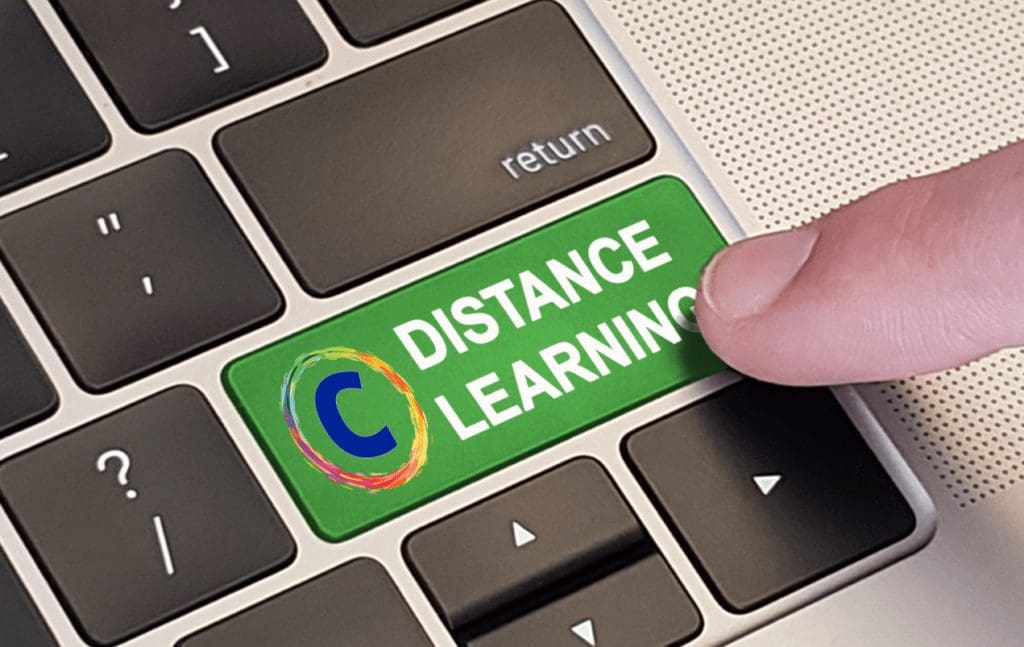Copyright and
Distance Learning

Tips and Resources for Teachers and Administrators
March 31, 2020
As teachers and students shift their educational and social activity online due to the COVID-19 crisis, they are more likely than ever to find themselves using and interacting with media in ways that raise copyright questions. As always, the free lessons and videos at C&C provide positive information about how to successfully navigate copyright and are readily usable for online learning. C&C will be offering some online training opportunities to help educators familiarize themselves with these lessons.
Educators may be wrestling in particular with how to determine when they are allowed to use media in their online teaching. For example, those of you who have done C&C’s free professional development course know that there is a classroom teaching exception which allows teachers to play or display copyrighted media in the classroom during face-to-face instruction, without having to rely on fair use. But that exception doesn’t apply to distance learning. So how should educators proceed as they scramble to build robust and engaging distance learning lessons? What happens when they want to include some copyrighted work in those online lessons?
The University of Minnesota has posted a helpful guide on copyright in teaching, and the University of Virginia has posted a guide on the issues involved in shifting a course from in-person to online. In general, it advises that most of the things that are okay in class should also be okay online, but you do need to be a little careful – for example, it’s a good idea to link to the original wherever possible, to make sure that online access is limited to enrolled students only, and to limit audio and video use to relatively brief clips where possible.
In general, there are three main options for using copyrighted material in online teaching: the TEACH Act, fair use, and permission.
The TEACH Act
The TEACH Act is the online counterpart to the in-class teaching exception. You can read a recent Copyright Office blog post explaining it here. It allows teachers at nonprofit accredited schools to perform (e.g., playing a song or video, reading aloud from a book) or display (e.g., showing an image) copyrighted works in online learning in ways that are analogous to a face-to-face class. But there are quite a few requirements, including some that need to be met by the educational institution rather than just the individual teacher. So if you want to rely on this, you’ll need to check with your school first. You can find good descriptions of TEACH Act requirements here and here, but they include:
- The educational institution must have a policy on the use of copyrighted materials and must provide informational resources about copyright to staff and students.
- There must be technological controls in place to ensure that only students enrolled in the class have access and to prevent students from downloading and distributing the material.
- Students must be informed that the materials are protected by copyright.
- The use of the material must be analogous to use within a face-to-face classroom, with the teacher supervising the use – i.e., the teacher can’t be just compiling a resource page of materials for independent learning.
- Materials marketed for the purpose of distance education (like electronic textbooks) are excluded.
Fair Use
Another option is, of course, fair use. As explained at some length in C&C’s resources, fair use is determined using a flexible, case-by-case, four-factor test. The good news is, teaching is a favored purpose under fair use, as it is explicitly mentioned in the law. And a group of library copyright specialists recently released a public statement explaining why they believe that in the current crisis, the reasonable use of copyrighted materials in distance learning will almost always be a fair use. On the specific question of read-aloud activities, several professors recently released a paper suggesting that in most cases, fair use should permit teachers to translate their regular classroom read-aloud practices to the online context. Nonetheless, fair use does require considering how the four factors apply to your individual circumstances.
Permission
Finally, a large body of materials is available to use with permission. This includes open educational resources (see, e.g., here) which have always been freely available under a broad grant of permission – like our resources here at C&C, which carry a Creative Commons license. In addition, a variety of organizations have begun to offer free or unlocked content for distance education in response to the current crisis. To list one prominent example, J.K. Rowling has announced permission for teachers to post videos of themselves reading aloud from her Harry Potter books. The Copyright Alliance is keeping a list of such offerings, as are the School Library Journal and the American Association of Publishers. It is also possible that your school or district has licenses with certain content providers that would include permissions for use in distance learning, so you may want to check on that.
________________
Rapidly shifting to online teaching poses challenges for educators, and it may feel frustrating to have copyright questions be a part of that mix. But the fundamental function of copyright in providing incentives to creators remains as important as ever in an all-digital, all-online environment. As we emphasize in C&C’s lessons, there are many things that copyright empowers — and we are all both consumers and creators of copyrighted work.
Good luck to all you teachers out there as you work to adapt to this difficult challenge. And as always, we’d welcome your feedback and your help in spreading the word about C&C.
(Note: C&C cannot provide legal advice. The information we provide here is general background and should not be interpreted as legal advice for you or your institution.)



